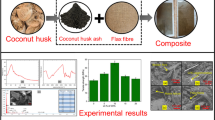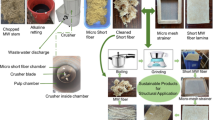Abstract
With water-soluble phenol-formaldehyde resin as an intermediate, Chinese fir (Cunninghamia lanceolata) wood/montmorillonite nanocomposite (WMNC) was prepared through vacuum impregnation and characterized with XRD, SEM, FTIR and TG-DTA analyses. The XRD analysis indicated that the wood crystallinity of WMNC decreased, the MMT exfoliated and some nano silicate layers entered into the non-crystallized microfibrillar region of the wood cell wall. Wood structure is anisotropic and its impregnation is anisotropic. Due to the nonuniformity of the MMT organic modification, PF intercalation and wood impregnation, the MMT configuration and distribution in wood were diverse. The SEM graphs of WMNC showed that some silicate grains were blocked in the wood cell lumen, some silicate layers adhered to the inner surface of the wood cell wall, and some exfoliated MMT layers even penetrated the wood cell wall. The obtained hydroxyl of WMNC increased and its ether linking decreased. It was considered that MMT and wood interacted not only with hydroxyl bonds, but also involved some chemical linking. Compared with untreated wood and the PF-impreg, the pyrolysis process of WMNC changed; its starting decomposing temperature decreased and its pyrolysis weight loss at high temperatures greatly decreased. The WMNC indicated certain nanoeffects of the composition of the inorganic MMT nanolamellae.
Similar content being viewed by others
References
Alexandre M, Dubois P (2000). Polymer-layered silicate nanocomposites: preparation, properties and uses of a new class of materials. Mater Sci Eng, 28: 1–63
Chen R Y, Wu C C (2000). Study on physical and mechanical properties of middle cutting wood of Cunninghamia lanceolata in Fujian Province. J Northeast For Univ, 28(4): 41–43 (in Chinese)
Ge M Y (1985). The Chemistry of Wood Processing. Harbin: Northeast Forestry University, 53 (in Chinese)
Giannelis E P, Krishnamoorti R, Manias E (1999). Polymer-silica nanocomposites: model systems for confined polymers and polymer brushes. Adv Polym Sci, 138: 107–147
Hu S Y, Huang B Z (2000) Analysis of DTA/TG curve of phenolic resin dipped wood powder. Chem Ind For Prod, 20(1): 47–51 (in Chinese)
Hu S Y, Zhang Z P, Huang B Z, Lin Q M, Deng S P (1998). Analysis of DTA/TG curve of wood flame retardant of inorganic. J Fujian Coll For, 18(2): 163–166 (in Chinese)
Kornmann X, Lindberg H, Berglund L A (2001). Synthesis of epoxy-clay nanocomposites: influence of the nature of the clay on structure. Polymer, 42(4): 1303–1310
Li J (2003) Wood Spectroscopy. Beijing: Science Press, 135 (in Chinese)
Lü W H, Zhao G J (2004). Design of wood/montmorillonite (MMT) intercalation nanocomposite. For Stud China, 6(1): 54–62
Lü W H, Zhao G J (2005). Nano intercalation compounding of wood/MMT nanocomposite (MMT). Sci Silv Sin, 41(1): 181–188 (in Chinese)
Nanjing Forestry University (1990). Wood Chemistry. Beijing: China Forestry Publishing House, 112 (in Chinese)
Peng Z H (1999). Chinese Fir. Beijing: China Forestry Publishing House, 3 (in Chinese)
Song X J (2000). The properties and industrial utilization of Chinese fir thinning. Wood Ind, 14(2): 27–29 (in Chinese)
Xiao Z P, Lu J S, Ma S C, Yang W B (2002). Study on chemical kinetics of fire retardant Chinese fir thinning by thermo gravimetric analysis. J Fujian Coll For, 22(2): 113–116
Yu X T (2000). A summary of the studies on Chinese fir in 1990’s II. Summary of the Chinese fir silviculture and management research development. J Fujian Coll For, 20(2): 97–100 (in Chinese)
Zhao G J (2002). Nanoscale in wood, nanowood and wood-inorganic nanocomposites. J Beijing For Univ, 24(5/6): 204–207 (in Chinese)
Zhao G J, Lü W H (2003). Nanoscale in wood, nanowood and wood-inorganic nanocomposites. For Stud China, 5(1): 44–48
Author information
Authors and Affiliations
Corresponding author
Additional information
__________
Translated from Journal of Beijing Forestry University, 2007, 29(1): 131–135 [译自: 北京林业大学学报]
About this article
Cite this article
Lü, W., Zhao, G. Structure and characterization of Chinese fir (Cunninghamia lanceolata) wood/MMT intercalation nanocomposite (WMNC). Front. For. China 3, 121–126 (2008). https://doi.org/10.1007/s11461-008-0020-0
Issue Date:
DOI: https://doi.org/10.1007/s11461-008-0020-0




